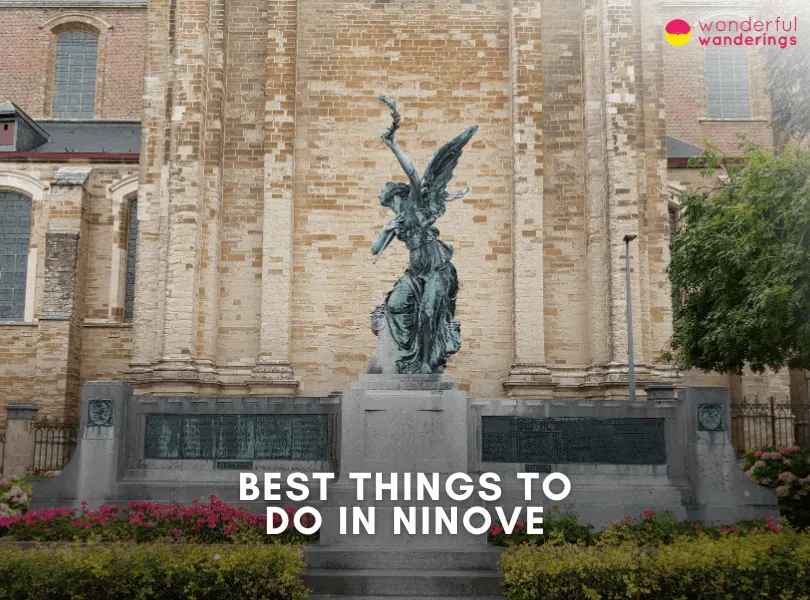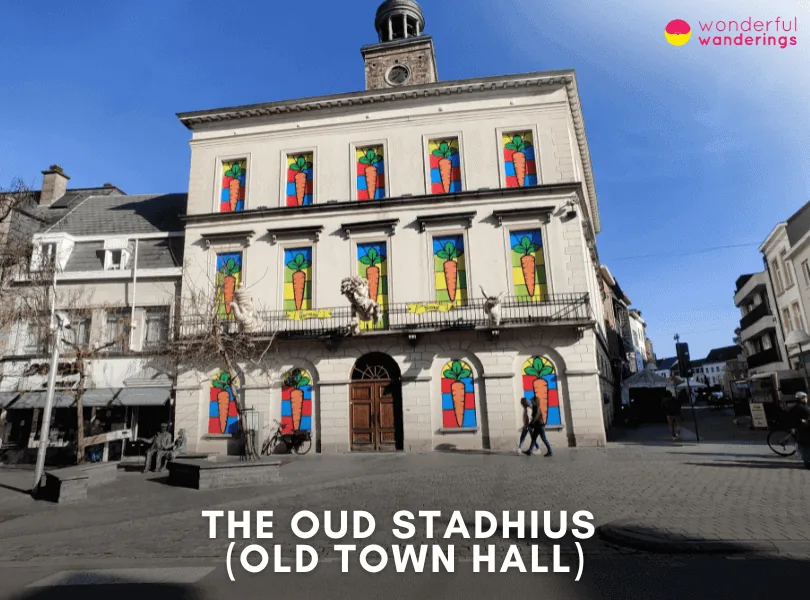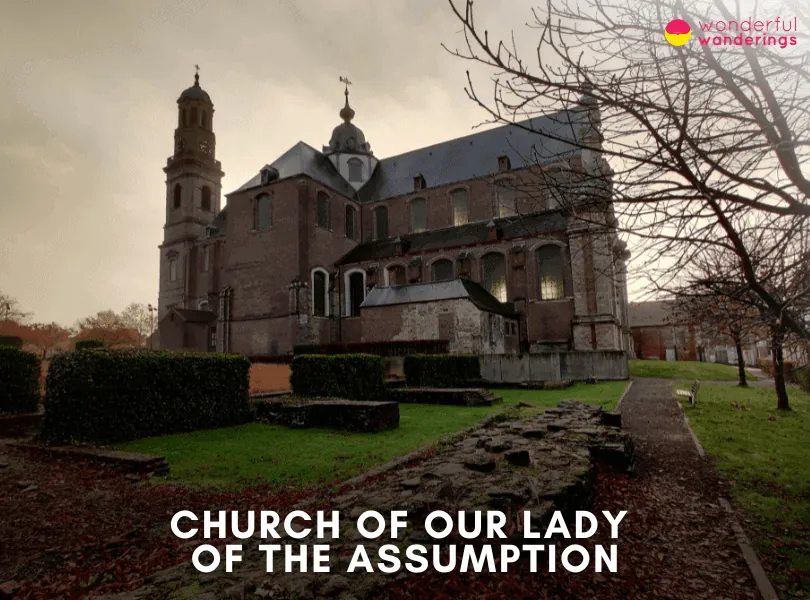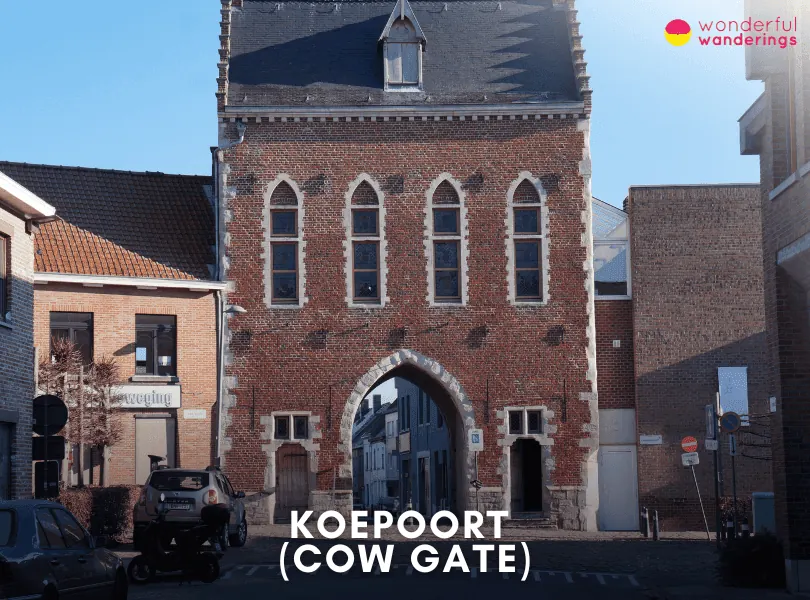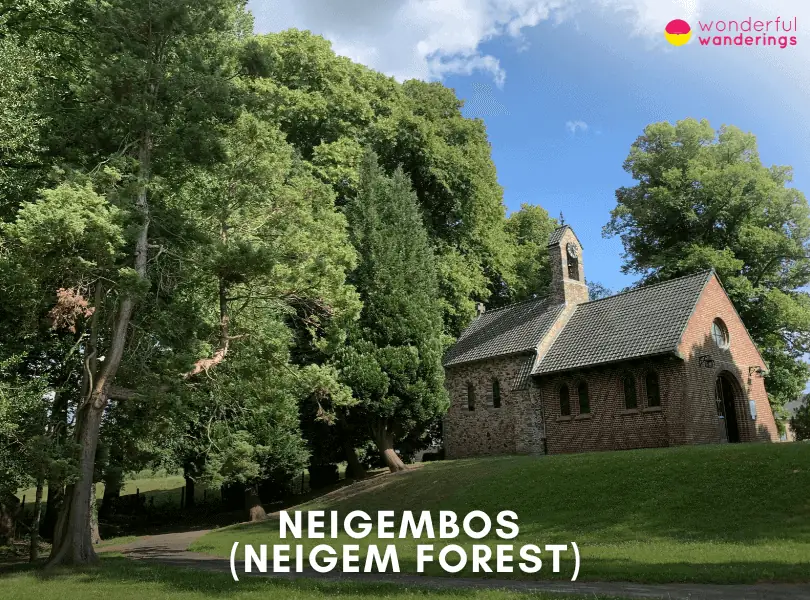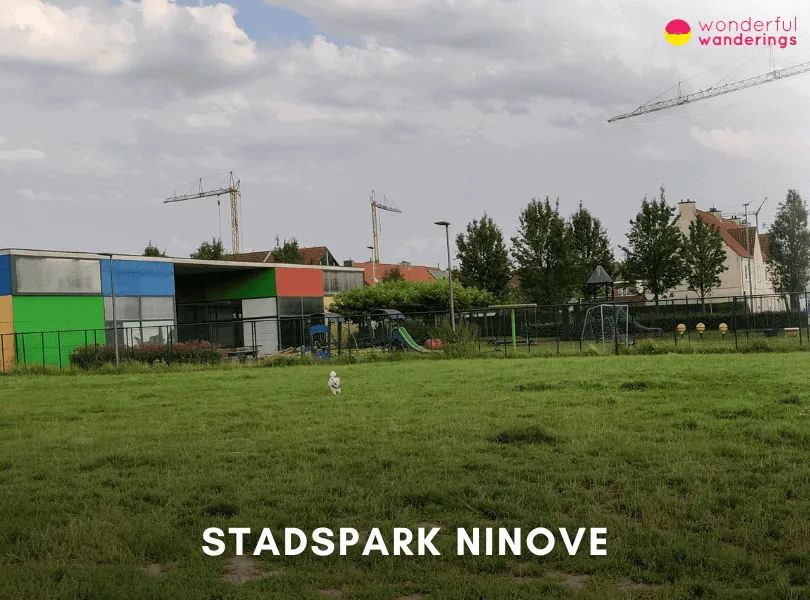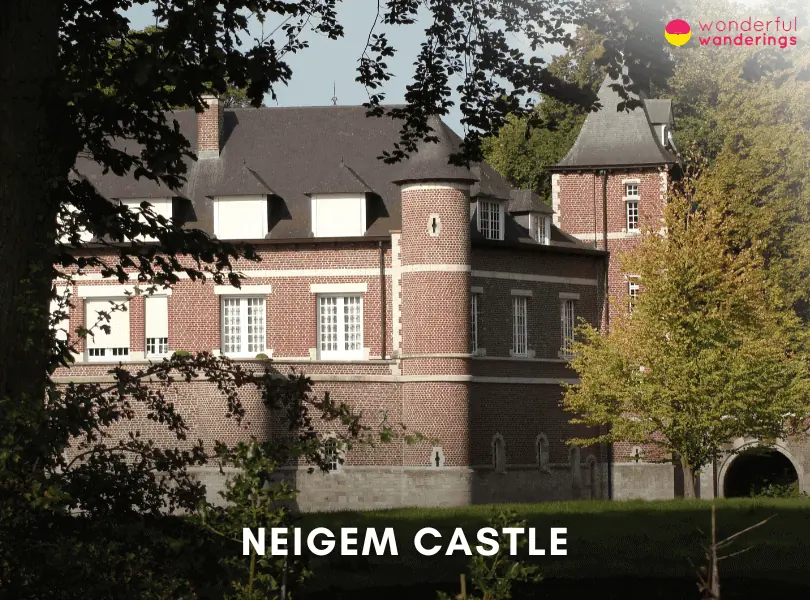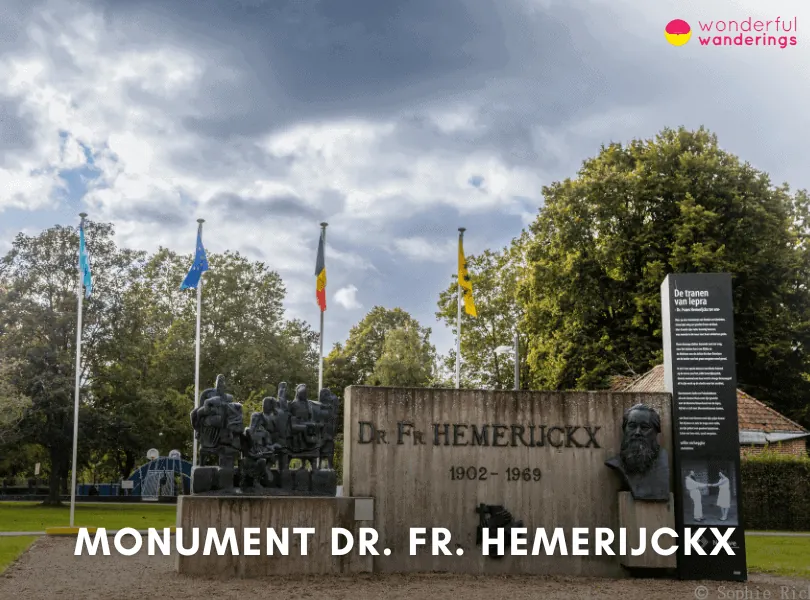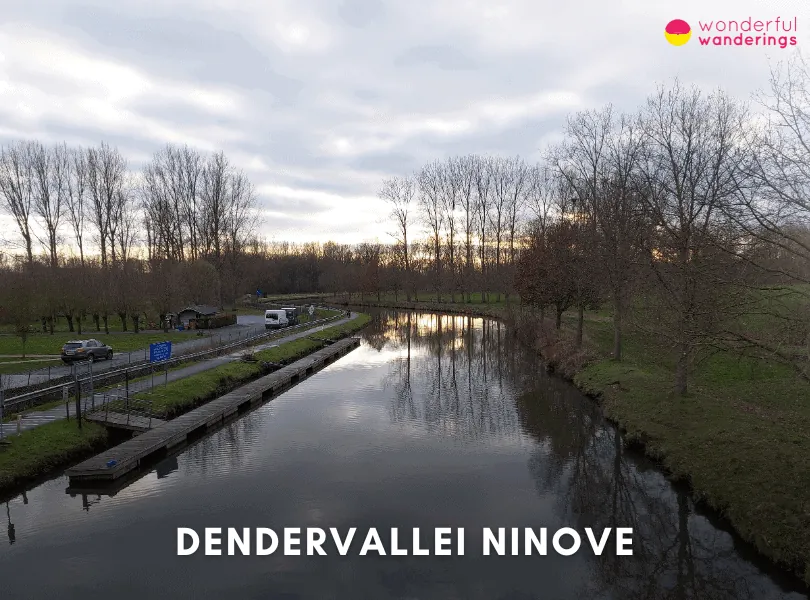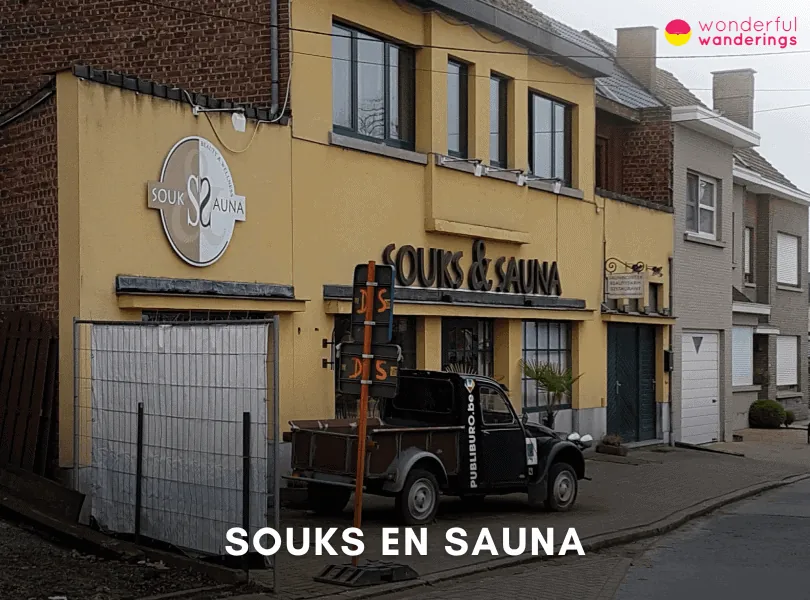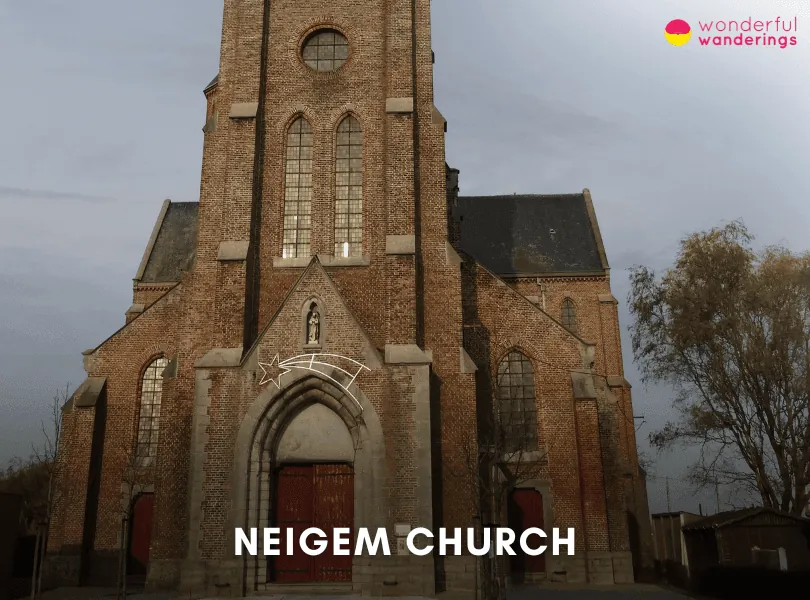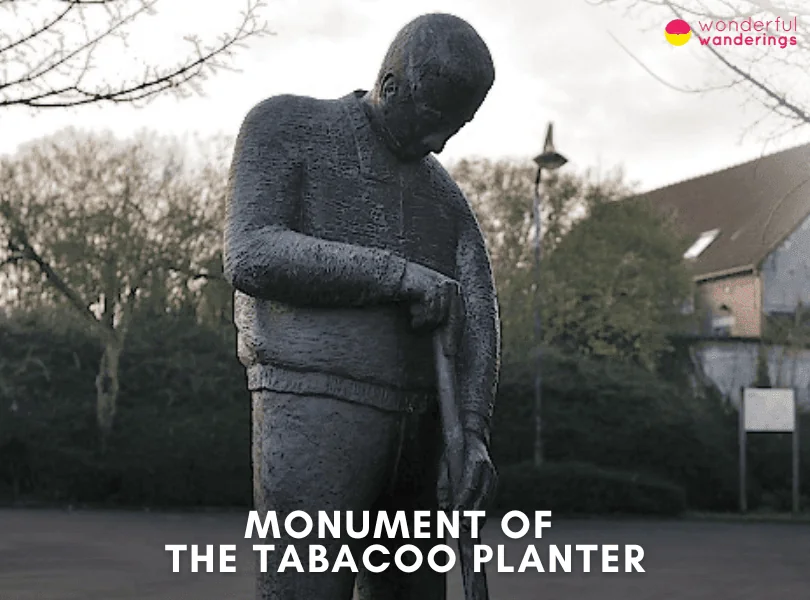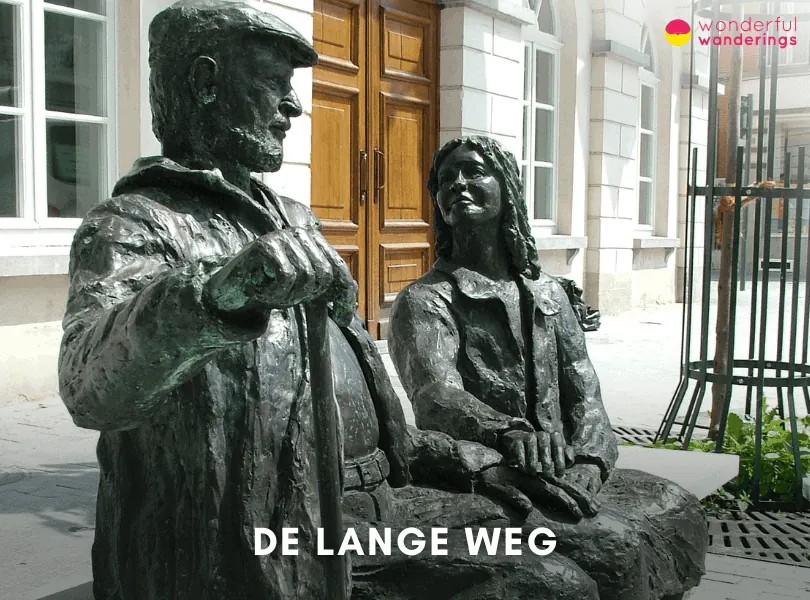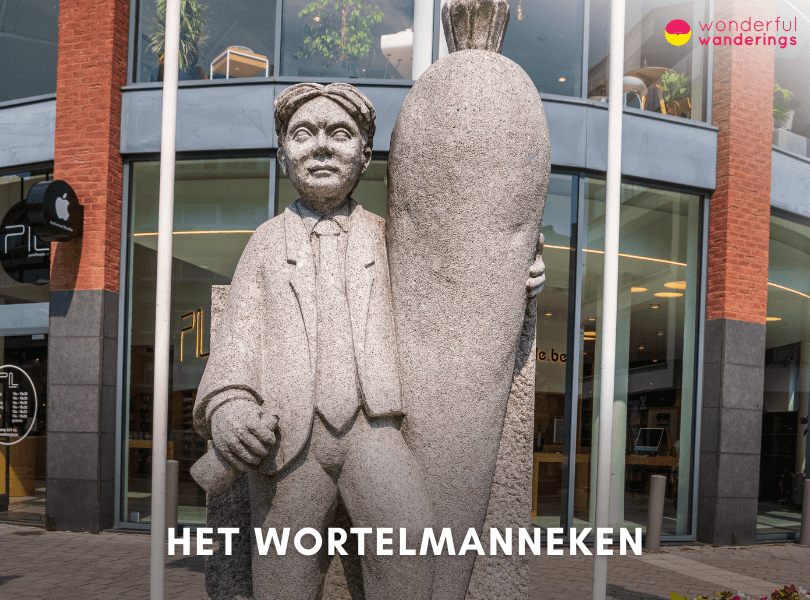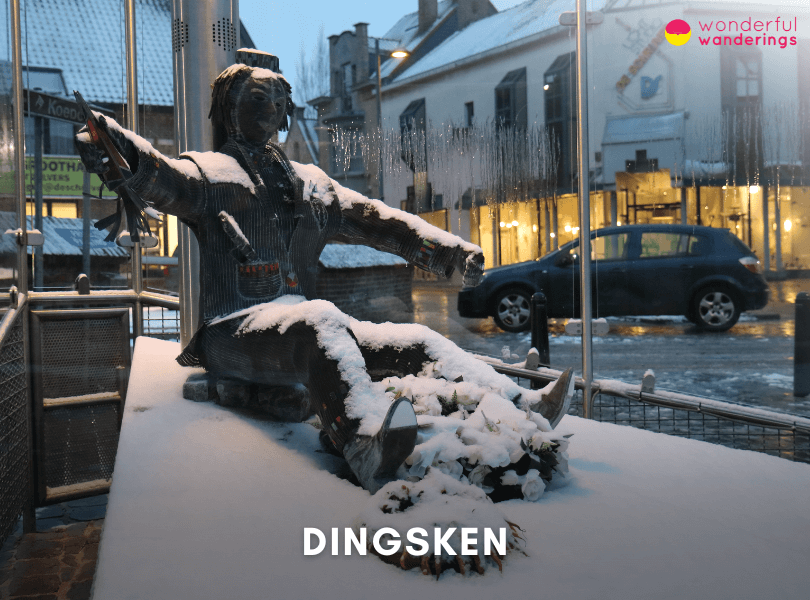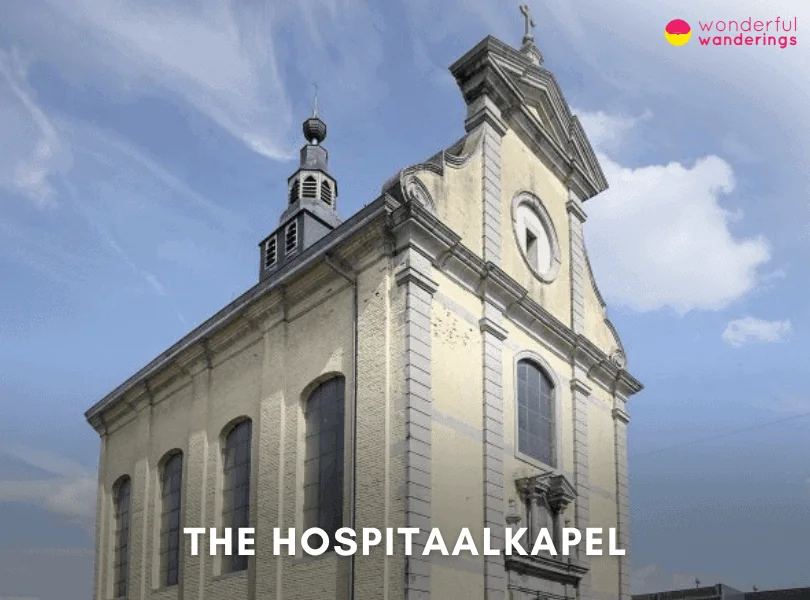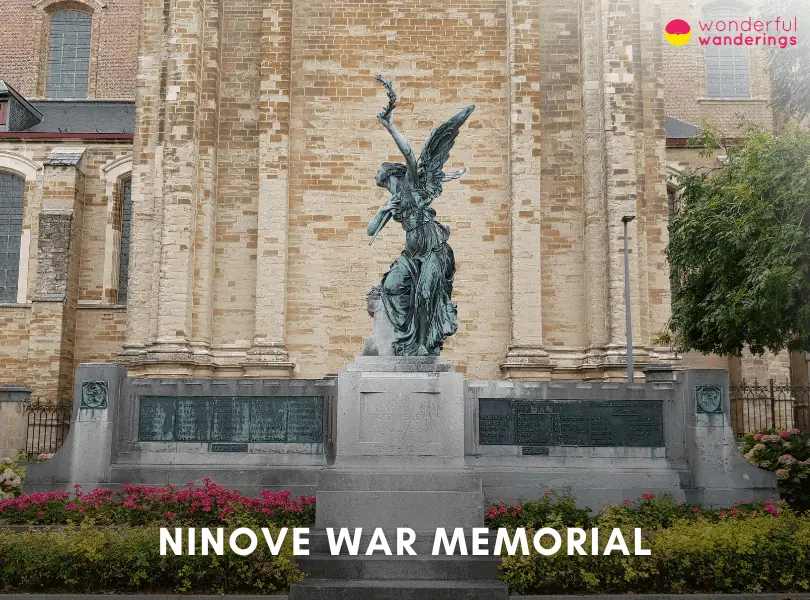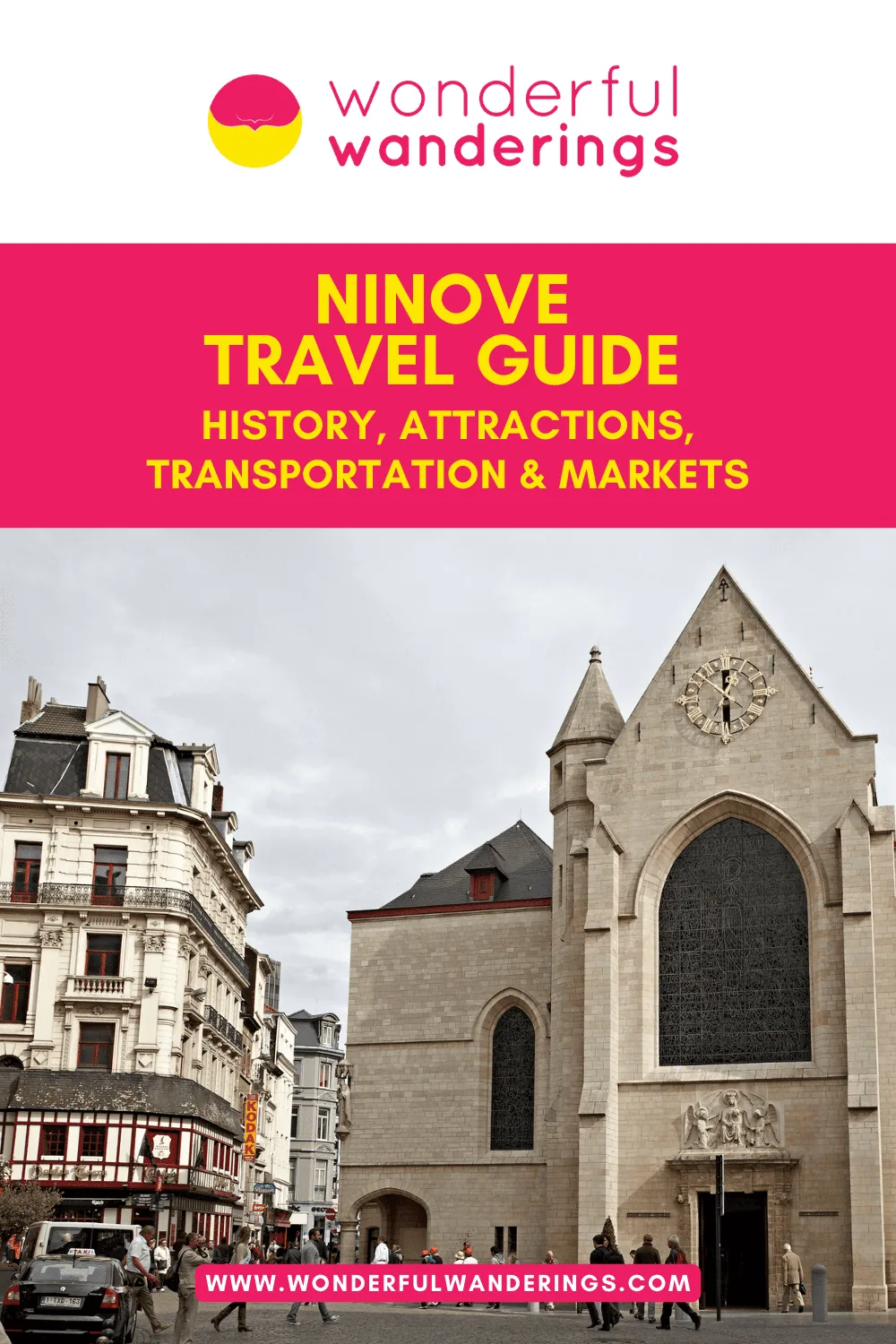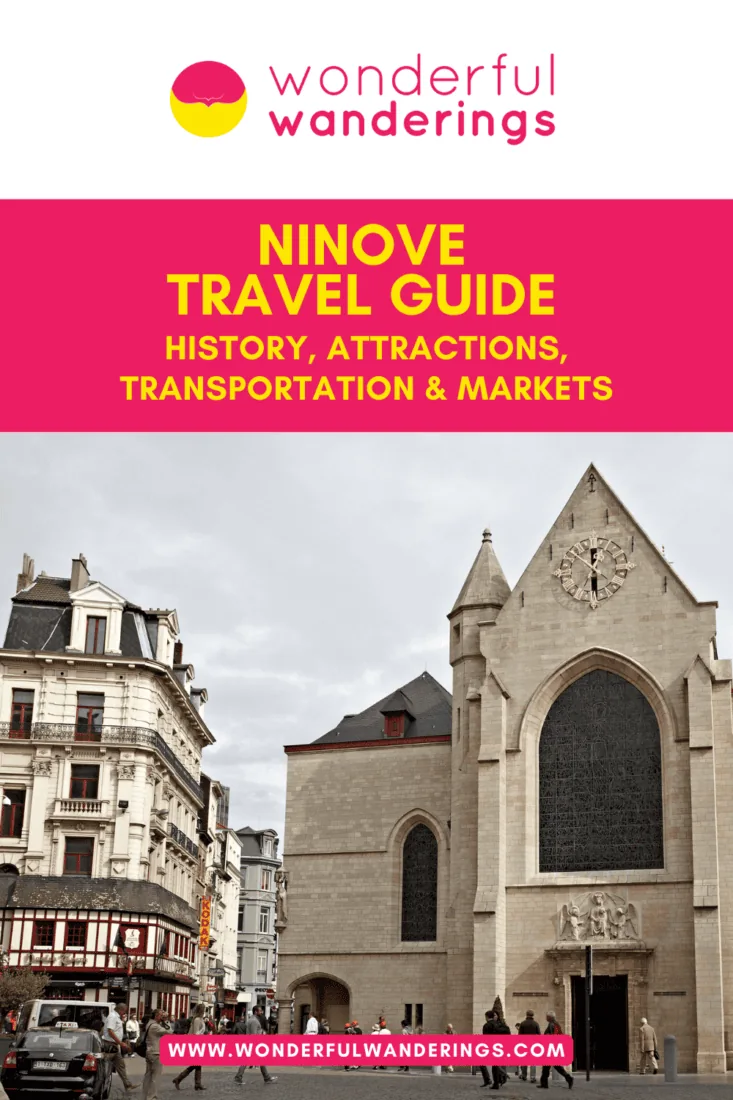Ninove is a city and municipality in the Flemish province of East Flanders in Belgium. It is pronounced as Ninive in French, Nienove in German and Ninova in Italian. Ninove means “new pasture” and has a history dating back to the 9th century. Ninove is located on the river Dender and is part of the Denderstreek, a region known for its agricultural and industrial activities. Ninove was once a fortified town and a trade center between Flanders and Brabant. It was also the site of a Norbertine abbey, founded in 1137 and plundered by the French in 1578. Ninove has experienced several wars and political changes over the centuries and is now a modern city with a population of 40,000.
Ninove is located in the Central European Time Zone (CET), one hour ahead of the Coordinated Universal Time (UTC). It observes daylight saving time during the summer and switches to the Central European Summer Time (CEST), two hours ahead of UTC. Ninove has a temperate climate with four distinct seasons. The summers are comfortable and partly cloudy, with an average temperature of 23 ℃ (73 ℉) in July, the warmest month. The winters are long, very cold, windy and mostly cloudy, with an average low temperature of 1 ℃ (34 ℉) in January, the coldest month. Ninove receives about 800 millimeters (31 inches) of rainfall annually, with the most rain falling in August and the least in April. Ninove also gets some snowfall in the winter, averaging 10 centimeters (4 inches) per year. Ninove is a city with a rich heritage and a diverse culture. It offers many attractions and activities for visitors, such as historical buildings, parks, festivals, sports and shopping. Ninove is also a good base for exploring the nearby cities of Brussels, Ghent and Antwerp, all within an hour’s drive.
Listed below are the best things to do in Ninove.
- The Oud Stadhius (Old Town Hall). The Oud Stadhius is a historic building in Ninove, Belgium, that dates back to the 14th century. It was the city’s administrative center for many years until it was replaced by a new town hall in 1984. The Oud Stadhius is a neoclassical structure with a square tower and a clock, designed by architect Louis Roelandt in 1834. It has been a protected monument since 1976 and was restored to its original form in 2010.
- Onze-Lieve-Vrouw Hemelvaartkerk (Church of Our Lady of the Assumption). Onze-Lieve-Vrouw Hemelvaartkerk is also known as the Abbey Church because it was part of the Norbertine Abbey of Saint Cornelius and Saint Cyprianus. The abbey was founded in 1137 by Countess Beatrix of Looz and her son Gerard, who donated their castle and lands to the Premonstratensians. The abbey flourished in the Middle Ages and became a powerful and wealthy institution, owning many properties and rights in the region.
- Koepoort (Cow Gate). Koepoort is a historical city gate in Ninove, Belgium, that dates back to the 14th century. It is the only surviving gate of the four that once protected the city from invaders. It was originally called the Warmoespoort because it led to the vegetable gardens outside the city walls. Later, it was renamed the Nederwijkpoort because it gave access to the lower district of the city. Finally, it became known as the Koepoort because farmers used it to bring their cows to the market.
- Neigembos (Neigem Forest). Neigembos is a forest in Ninove, Belgium, part of the ancient “Coal Forest” stretching from Picardy to Brabant in Roman times. It covers an area of 100 hectares and has a varied relief ranging from 20 to 90 meters above sea level. The forest is rich in biodiversity and has many species of trees, plants, birds and animals.
- Stadspark Ninove. Stadspark Ninove is a public park in the city of Ninove, Belgium. It is also known as the City Park of Ninove or Parc de la Ville de Ninove in French. It has many trees, flowers, lawns and ponds that create a natural and relaxing environment. It also has a rich history and cultural heritage, as it was once the site of a medieval castle and a monastery. Some historical buildings and monuments can still be seen in the park, such as the Chapel of Our Lady of Grace, the Castle Tower and the War Memorial.
- Neigem Castle. Neigem Castle is a medieval castle in the village of Neigem, part of the city of Ninove, Belgium. It is also known as the Castle of Neigem or Kasteel van Neigem in Dutch. The castle is on a hill, surrounded by a moat and a park. It dates back to the 12th century when it was built by the lords of Neigem as a fortified residence. The castle was later expanded and renovated several times, especially in the 15th and 16th centuries, when it became a Renaissance-style palace. It was damaged by wars and fires in the 17th and 18th centuries and was partly restored in the 19th and 20th centuries. The castle is now a private property and a protected monument.
- Monument Dr. Fr. Hemerijckx. Monument Dr. Fr. Hemerijckx is a bronze statue that honors the life and work of Dr. Frans Hemerijckx, a Flemish leprologist and humanist who founded the Damien Foundation, a non-governmental organization that provides treatment and rehabilitation services to people affected by leprosy. The statue was sculpted by Jef Claerhout and unveiled in 1982 in the city of Ninove, Belgium, where Hemerijckx was born in 1902. The monument depicts Hemerijckx holding a leprosy patient in his arms, symbolizing his compassion and dedication to the cause.
- Dendervallei Ninove. Dendervallei Ninove is a natural and scenic area in Ninove, Belgium. It is located on the left bank of the Dender River, between Zandbergen and Ninove. It covers the territory of Appelterre-Eichem, Outer and Ninove municipalities. Dendervallei Ninove has different vegetation types: valley forest, poplar plantation, coppice scrub, marsh, meadow, buttercup grassland, species-rich grassland and grazing pasture. It also has rare and beautiful flowers, such as yellow and pink rattle, field peas, marsh clover, wood sedge, wood orchids and spotted orchids.
1. The Oud Stadhius (Old Town Hall)
The Oud Stadhius is a historic building in Ninove, Belgium, that dates back to the 14th century. It was the city’s administrative center for many years until it was replaced by a new town hall in 1984. The Oud Stadhius is a neoclassical structure with a square tower and a clock, designed by architect Louis Roelandt in 1834. It has been a protected monument since 1976 and was restored to its original form in 2010. The Oud Stadhius is also known as Café ‘t Oud Stadhuis because it houses a café on the ground floor. The café is a popular meeting place for locals and visitors, offering a variety of drinks and snacks. The café hosts live music and cultural events, such as poetry readings and book launches. It is open from Tuesday to Sunday, from 10:00 am to 01:00 am.
The Oud Stadhius is located near the city center at Oudstrijdersplein, Ninove 9400, Belgium. It is close to attractions like the Abbey Church of Saint Cornelius and Saint Cyprian, the Ninove City Museum and the Dender River. The Oud Stadhius is 30 kilometers (19 miles) from Brussels, the capital of Belgium and can be reached by car, train or bus. The Oud Stadhius reflects the history and culture of Ninove, a city once a prosperous trading center and a stronghold of the Counts of Flanders. It witnessed many important events, such as the great fire of 1603, the French occupation of 1794 and the liberation of 1944. The old city hall also showcases the architectural style and craftsmanship of Louis Roelandt, who also designed the tower of the Abbey Church.
Visitors can enjoy a drink or a bite at the café and mingle with the friendly staff and customers. They can listen to live music, watch a performance at the café’s stage and discover new talents and genres. They can also explore the upper floors of the building, where they can find the offices of the city’s cultural, events and information services. Visitors can also view exhibitions and artworks or attend meetings and workshops in the spacious and elegant rooms. They can also witness a wedding ceremony or even get married themselves in the historical and romantic setting of the Oud Stadhius.
2. Onze-Lieve-Vrouw Hemelvaartkerk (Church of Our Lady of the Assumption)
Onze-Lieve-Vrouw Hemelvaartkerk is a three-aisled baroque church in Ninove, Belgium, consecrated in 1727 as the abbey church of the Premonstratensians after a nearly 100-year construction history. It was built in brick and Lede sandstone with a distinctive floor plan and southwest facade. Since 1813, it has served as the parish church, but Abbot Ferdinand Vander Haeghen had a double purpose: the choir and transepts would serve as the monastery church, while the nave would serve as the pilgrimage church. The square east tower with a hexagonal lantern was only added in 1825 to 1844 under the direction of architect Louis Roelandt (1786-1864). The bright, richly decorated interior with a striking stylistic unity makes the church one of the country’s most important places of worship and one of the most complete artistic creations of the Dender region. The extensive choir stalls and the pulpit date from the 17th century and were transferred from the older parish church, which was demolished in 1816 to 1828, but the rest of the furnishings in classicizing baroque and Régence style were entirely created under the direction of Abbot Vander Haeghen during the first half of the 18th century. The paneling on each side wall of the nave contains ten painted scenes each about the saints Cornelius and Cyprianus, to whom the former abbey church was dedicated. Not to be missed is the inside of the central dome, decorated with stucco.
Onze-Lieve-Vrouw Hemelvaartkerk is also known as the Abbey Church because it was part of the Norbertine Abbey of Saint Cornelius and Saint Cyprianus. The abbey was founded in 1137 by Countess Beatrix of Looz and her son Gerard, who donated their castle and lands to the Premonstratensians. The abbey flourished in the Middle Ages and became a powerful and wealthy institution, owning many properties and rights in the region. It also played a significant role in the religious, cultural and social life of Ninove and its surroundings. The French Revolution suppressed the abbey in 1796, where its buildings were sold and partly demolished, with only the church and some parts of the cloister remaining. The church became the property of the city of Ninove in 1813 and was assigned to the parish of Our Lady of the Assumption. The abbey’s history and heritage remain visible in the church’s architecture, art and relics.
Onze-Lieve-Vrouw Hemelvaartkerk is located near the city center at Kerkplein, Ninove, East Flanders, 9400. It is close to other attractions like the Old Town Hall, the Ninove City Museum and the Dender River. Onze-Lieve-Vrouw Hemelvaartkerk is 30 kilometers (19 miles) from Brussels, the capital of Belgium and can be reached by car, train or bus. Firstly, visitors can take the E40 motorway by car, exit Aalst and then follow the N45 and N28 roads to Ninove. Secondly, if by train, one can take line 90 from Brussels to Denderleeuw, then change to line 89 to Ninove. The church is a 10-minute walk from the Ninove train station. Lastly, one can take the De Lijn bus 128 from Brussels to Ninove or the bus 41 from Aalst to Ninove. The church is a 5-minute walk from the Ninove bus station.
Onze-Lieve-Vrouw Hemelvaartkerk is a pilgrimage site of Saint Cornelius, the patron saint of cattle, earache and epilepsy. Saint Cornelius was the pope from 251 to 253 and suffered martyrdom under Emperor Decius. His relics were brought to Ninove in 1402 by Abbot Gerard van der Schelden, who obtained them from Pope Boniface IX. The relics are kept in a silver shrine in the shape of a basilica, made by goldsmith Jan van den Steene in 1629. The shrine is displayed on the main altar on the feast day of Saint Cornelius, September 16 and on other special occasions. Many pilgrims come to the church to venerate the relics and ask for the intercession of Saint Cornelius. The church also has a statue of Saint Cornelius, made by sculptor Jan van der Steene in 1630. The statue is carried in procession through the city on the Sunday after September 16, accompanied by the brotherhood of Saint Cornelius and the local fanfare. The church also has a fountain of Saint Cornelius, built in 1635, where pilgrims can drink water that is said to have healing properties.
3. Koepoort (Cow Gate)
Koepoort is a historical city gate in Ninove, Belgium, that dates back to the 14th century. It is the only surviving gate of the four that once protected the city from invaders. It was originally called the Warmoespoort because it led to the vegetable gardens outside the city walls. Later, it was renamed the Nederwijkpoort because it gave access to the lower district of the city. Finally, it became known as the Koepoort because farmers used it to bring their cows to the market. The gate was rebuilt around 1600 in sandstone from the quarries of Geraardsbergen. It served as a city prison, a powder and weapon storage, a residence for the poor, a fire station and a library. It was restored in 2012 and now hosts cultural events and exhibitions. The gate has a rectangular shape with two round towers and a pointed roof. It has a coat of arms of the city of Ninove on the front and a sundial on the back. The gate is a remarkable example of Ninove’s military and architectural heritage and a symbol of its history and identity.
Koepoort means “cow gate” in Dutch, the official language of Ninove and the Flemish region of Belgium. The name is pronounced as “koo-port” with a long “o” sound. Koepoort is also used for other city gates in the Netherlands and Belgium, such as Leiden, Mechelen and Antwerp. Koepoort is located at Koepoortstraat, Ninove, East Flanders, 9400. It is close to other attractions like the Old Town Hall, the Ninove City Museum and the Dender River. It is 30 kilometers (19 miles) from Brussels, the capital of Belgium and can be reached by car, train or bus. Koepoort shows the evolution of the city of Ninove from a medieval fortress to a modern municipality. It also features some interesting details, such as the coat of arms, the sundial and the inscription “S.P.Q.N”., which stands for “Senatus Populusque Ninoviensis”, meaning “The Senate and the People of Ninove” in Latin.
Visitors can do many things in Koepoort, depending on the season and the schedule. They can admire the gate’s exterior and interior, learn about its history and significance and take pictures of its beauty and charm. Visitors can also attend various events and exhibitions that are organized at the gate, such as concerts, lectures, workshops and art shows. They can also explore the surroundings of the gate, such as the old town, the river and the park. Visitors can also enjoy the local cuisine and specialties, such as the mattentaart, a pastry made with cheese curd and almond paste or the Oud Ninove, a blond beer brewed in the city.
Koepoort is best for visitors who are interested in history, culture and architecture. It is suitable for people of all ages and backgrounds, as it offers a variety of activities and experiences. It is also ideal for people who want to discover a lesser-known but fascinating city in Belgium with a rich heritage and a friendly atmosphere. Koepoort is a great destination for a day trip or a weekend getaway, as it is easily accessible and affordable. The admission fee for entering Koepoort (Cow Gate) is free of charge. However, some events and exhibitions may require a fee or a reservation. Visitors can also donate to support the maintenance and promotion of the gate.
4. Neigembos (Neigem Forest)
Neigembos is a forest in Ninove, Belgium, part of the ancient “Coal Forest” stretching from Picardy to Brabant in Roman times. It covers an area of 100 hectares and has a varied relief ranging from 20 to 90 meters above sea level. The forest is rich in biodiversity and has many species of trees, plants, birds and animals. It is also known for its historical and cultural significance, as it has been the site of battles, legends and traditions. It is a protected natural area and a popular destination for nature lovers and hikers. Neigembos is also called the Neigem Forest, depending on the language and preference. It means “forest of Neigem” in Dutch, which is derived from the Celtic word “nemetum”, which means “sacred grove”. It is pronounced as “nay-hem-bos” with a soft “g” sound. The name Neigembos is also used for other forests in Belgium, such as the ones in Brakel and Zottegem.
Neigembos is located at Neigembosstraat, Ninove, East Flanders, 9403, near the village of Neigem. It is close to other attractions, such as the Neigem Church, the Neigem Castle and the Neigem Mill. It is 35 kilometers (22 miles) from Brussels, the capital of Belgium and can be reached by car, train or bus. It provides a habitat for many rare and endangered species of flora and fauna, such as the European beech, the wild orchid, the woodpecker and the badger. The forest is also famous for its bluebells, which bloom in April and May and create a carpet of blue flowers. It is also a place of legends and folklore, such as the story of the giant Lange Wapper, who terrorized the villagers of Neigem or the tradition of the Neigem Procession, which is held every year on the first Sunday of July.
Visitors can do many things in Neigembos (Neigem Forest), depending on the season and the interest. Firstly, they can admire the forest’s beauty and diversity, learn about its history and ecology and take pictures of its scenery and wildlife. Secondly, visitors can enjoy various activities and sports, such as hiking, cycling, horse riding and orienteering or participate in guided tours, workshops and events that are organized in the forest, such as the Bluebell Festival, the Forest Day or the Night of the Bat. Lastly, they can also explore the surroundings of the forest, such as the village of Neigem, the church, the castle and the mill or taste the local cuisine and specialties, such as cheese, beer or cake.
5. Stadspark Ninove
Stadspark Ninove is a public park in the city of Ninove, Belgium. It is also known as the City Park of Ninove or Parc de la Ville de Ninove in French. The park is located at Ganzeweide, Ninove, near the Dender River and the city center. The park covers an area of 10 hectares and offers a variety of attractions and activities for visitors of all ages. The main features of Stadspark Ninove is its beautiful landscape and greenery. It has many trees, flowers, lawns and ponds that create a natural and relaxing environment. It also has a rich history and cultural heritage, as it was once the site of a medieval castle and a monastery. Some historical buildings and monuments can still be seen in the park, such as the Chapel of Our Lady of Grace, the Castle Tower and the War Memorial.
Stadspark Ninove also has a large and modern playground for children, with swings, slides, climbing frames and sandboxes. The playground is fenced and supervised by staff for safety and comfort. The park also has a skate park, a basketball court, a mini golf course and a petanque court for sports lovers. It also hosts various events and festivals throughout the year, such as the Tribù Festival, a one-day house and techno music festival and the Park Concerts, a series of free concerts featuring local and national artists.
To get to Stadspark Ninove, visitors can take public transportation or drive by car. The park is easily accessible by bus, as there are several bus stops near the park entrance. The nearest bus stop is Stadspark, which is served by lines 31, 32, 33, 34 and 35. It is also close to the Ninove train station, which is 1.5 kilometers (0.9 miles) away. Visitors can walk or take a taxi from the station to the park and if by car, they can take the E40 motorway and exit at Aalst, then follow the N45 and N28 roads to Ninove. The park has a free parking lot for visitors.
Stadspark Ninove is suitable for a wide range of audiences, as it has something for everyone. The park is ideal for families with children, as they can enjoy the playground, the mini golf and the events. The park is also great for couples and friends who want to relax, picnic or stroll. It is also a popular destination for nature lovers, history buffs and music fans, as they can appreciate the park’s scenery, heritage and entertainment. The park is open every day from 08:00 am to 10:00 pm and admission is free.
6. Neigem Castle
Neigem Castle is a medieval castle in the village of Neigem, part of the city of Ninove, Belgium. It is also known as the Castle of Neigem or Kasteel van Neigem in Dutch. The castle is on a hill, surrounded by a moat and a park. It dates back to the 12th century when it was built by the lords of Neigem as a fortified residence. The castle was later expanded and renovated several times, especially in the 15th and 16th centuries, when it became a Renaissance-style palace. It was damaged by wars and fires in the 17th and 18th centuries and was partly restored in the 19th and 20th centuries. The castle is now a private property and a protected monument.
Neigem Castle is one of the oldest and best-preserved castles in Belgium. The castle has a rich and varied history, witnessing many historical events and hosting many famous guests. It was involved in the wars between Flanders and Brabant, the Hundred Years’ War, the Eighty Years’ War and the French Revolution. The castle was also the residence of several noble families, such as the de Lalaing, the de Glymes, the de Merode and the de Ligne. It also welcomed royal visitors like Philip the Good, Charles V and Maria Theresa. Neigem Castle is open to the public for guided tours, exhibitions, concerts and other events. Visitors can learn about the history and architecture of the castle, admire the artwork and furniture and enjoy the music and atmosphere. It also has a chapel, a tower, a courtyard and a dungeon that can be explored. The castle park is also open to the public and visitors can walk, bike or picnic along with the trees, flowers, ponds and statues, creating a pleasant and scenic environment.
To get to Neigem Castle, visitors can take public transportation or drive by car. The castle is 3 kilometers (1.9 miles) from the Ninove train station, which is connected to Brussels, Ghent and other cities by regular trains. The nearest bus stop is Neigem Kerk, which is served by line 22. If driving a car, visitors can take the E40 motorway and exit at Aalst, then follow the N45 and N28 roads to Ninove. The castle is located at Halsesteenweg 357, 9403 Ninove, Belgium and has a parking lot for visitors. Neigem Castle is ideal for history and culture lovers. It is also great for families and children, as they can have fun and learn in the castle and the park. The castle is also a popular destination for weddings, parties and other celebrations, as it offers a romantic and festive setting.
7. Monument Dr. Fr. Hemerijckx
Monument Dr. Fr. Hemerijckx is a bronze statue that honors the life and work of Dr. Frans Hemerijckx, a Flemish leprologist and humanist who founded the Damien Foundation, a non-governmental organization that provides treatment and rehabilitation services to people affected by leprosy. The statue was sculpted by Jef Claerhout and unveiled in 1982 in the city of Ninove, Belgium, where Hemerijckx was born in 1902. The monument depicts Hemerijckx holding a leprosy patient in his arms, symbolizing his compassion and dedication to the cause. The monument is also known as the Leprosy Monument or the Damien Monument, after Father Damien, a Belgian priest who ministered to leprosy patients in Hawaii and died of the disease in 1889. Hemerijckx was inspired by Damien’s example and decided to devote his life to fighting leprosy, first in Congo and then in India, where he established a mobile clinic under the trees and treated thousands of patients. He also advocated for the human rights and dignity of leprosy patients, who were often stigmatized and marginalized by society. The monument is located at the intersection of Burchtstraat and Centrumlaan, near the city center of Ninove.
Monument Dr. Fr. Hemerijckx is a special attraction for visitors interested in the history and culture of Ninove and the humanitarian legacy of Hemerijckx and the Damien Foundation. Visitors can learn more about the life and work of Hemerijckx from the information panels near the statue and from the nearby museum, which displays his personal belongings, photographs and documents. Visitors can also pay tribute to Hemerijckx and his patients by placing flowers or candles at the statue’s base or by donating to the Damien Foundation, which continues supporting leprosy programs in 16 countries worldwide. The monument is best suited for an adult audience who can appreciate the historical and social significance of Hemerijckx and his work. The monument is not very suitable for children, who may find the statue disturbing or boring. However, children may enjoy the museum, which has interactive exhibits and games that teach them about leprosy and the Damien Foundation.
The admission fee for entering Monument Dr. Fr. Hemerijckx is free, as it is a public space open to everyone. Visitors are encouraged to make a voluntary contribution to the Damien Foundation, which can be done online or at the museum. The admission cost of entering the museum is 5 € ($5.6, £4.1) for adults, 3 € ($3.4, £2.5) for students and seniors and free for children under 12. The museum is open from Tuesday to Sunday, from 10:00 am to 05:00 pm.
8. Dendervallei Ninove
Dendervallei Ninove is a natural and scenic area in Ninove, Belgium. It is located on the left bank of the Dender River, between Zandbergen and Ninove. It covers the territory of Appelterre-Eichem, Outer and Ninove municipalities. It is also known as Dendervallei | Natuurpunt, which means Dender Valley | Nature Point in Dutch. The area is 50 hectares and is managed by the non-profit organization Natuurpunt. Dendervallei Ninove has different vegetation types: valley forest, poplar plantation, coppice scrub, marsh, meadow, buttercup grassland, species-rich grassland and grazing pasture. It also has rare and beautiful flowers, such as yellow and pink rattle, field peas, marsh clover, wood sedge, wood orchids and spotted orchids. The area is home to many mammals, birds, amphibians and butterflies, some of which are endangered or protected. The area hosts the water shrew, the water bat, the stone owl, the bluethroat, the Cetti’s warbler, the nightingale, the green frog, the vinpoot salamander, the yellow lucerne butterfly and the kingfisher.
Dendervallei Ninove is a great place for visitors who love nature and outdoor activities. Firstly, they can explore the area by walking, cycling or canoeing along the Dender River and enjoy the stunning river and landscape views. Secondly, visitors can also learn about the history and culture of Ninove and the Dender region through the heritage and monuments of the area, such as the Neigem Church, the Pollare Mill, the Outer Castle and the Ninove Abbey. Lastly, the area also offers recreational facilities, such as a playground, a picnic area, a birdwatching hut and a visitor center. It is open daily from 05:00 am to 05:00 pm, except on Mondays and public holidays.
Dendervallei Ninove is best for visitors interested in ecology, wildlife and culture. The area is a valuable and unique natural reserve that showcases the beauty and diversity of the Dender Valley. It is also a place of education and conservation for the locals and visitors. Visitors can appreciate the area’s nature and heritage and support its protection and management. The admission fee for entering Dendervallei Ninove is free. Visitors are encouraged to make a donation to support the maintenance and preservation of the area and its wildlife. They can also buy souvenirs and books from the visitor center, which is open on Sundays from 10:00 am to 12:00 pm and from 02:00 pm to 04:00 pm.
9. Souks en Sauna
Souks en Sauna is a wellness complex in an oriental style with a variety of saunas, jacuzzis, a swimming pool, a hammam, a restaurant and a beauty farm. It is located in the green outskirts of Ninove. Souks en Sauna offers a relaxing and exotic experience for its visitors, who can enjoy the warm and cozy atmosphere, the delicious food and drinks and the professional beauty treatments. It is also known as Souksensauna or Souks & Sauna and has 10 different sauna and hammam options, each with its own theme and temperature. Some of the unique saunas are made of fire trees that are over 100 years old. There are also jacuzzis, a swimming pool, a relaxation room and a garden where visitors can unwind and refresh themselves. Souks en Sauna also has a restaurant that serves tasty and healthy dishes inspired by the Moroccan cuisine. The menu includes salads, soups, sandwiches, tagines, couscous and desserts.
Visitors can also enjoy a variety of drinks, such as tea, coffee, juice, wine and beer.
It also has a beauty farm where visitors can pamper themselves with various treatments, such as massages, facial care, pedicures, manicures, waxing and tanning. The beauty farm uses natural and organic products like argan oil, rose water and henna. The staff are friendly and professional and can advise visitors on the best treatments for their needs and preferences. It also offers packages and gift vouchers for special occasions like birthdays, anniversaries and Valentine’s Day. Souks en Sauna is easy to reach by car or public transport. Firstly, visitors can take the E40 motorway and exit at Aalst, then follow the signs for Ninove by car. It is 15 kilometers (9 miles) from Aalst and 35 kilometers (22 miles) from Brussels. Secondly, by public transport, visitors can take the train to Ninove station, then take bus number 41 or 42 to Meerbeke, which is 2 kilometers (1 mile) from the bus stop.
Souks en Sauna is suitable for a wide range of audiences, such as couples, families, friends and groups. It is a great place to relax, have fun and escape from the stress and noise of everyday life. Souks en Sauna is open every day from 11:00 am to 11:00 pm, except on Tuesdays when it is closed. The admission cost of entering Souks en Sauna is 23 € ($26, £19) per person for a day pass or 18 € ($20, £15) per person for a half-day pass from 11:00 am to 04:00 pm or from 05:00 pm to 11:00 pm. Visitors can also buy a 10-entry card for 180 € ($203, £147) or a yearly subscription for 750 € ($847, £614). The prices include using all facilities, towels, bathrobes and slippers. The beauty treatments and the restaurant are not included in the admission cost and require a separate reservation.
10. Neigem Church
Neigem Church is a historic and religious site in Ninove, Belgium. It is also known as Sint-Margaretakerk, which means Saint Margaret’s Church in Dutch. The church is located at Halsesteenweg 370, 9403 Neigem, Belgium, 4 kilometers (2.5 miles) from the city center of Ninove. It is a rare example of brick Gothic architecture in East Flanders, dating back to the 15th century and has a remarkable tower with four corner turrets. It also contains valuable artworks, such as a 17th-century painting of Saint Margaret and a 16th-century wooden statue of Saint Roch. Visitors can explore the church and admire its exterior and interior features. They can learn about the history and culture of Neigem and Ninove through the church’s heritage or participate in the religious services and events held regularly. It is open every day from 09:00 am to 05:00 pm, except on Mondays and public holidays. Visitors can also take photos of the church and its artworks but cannot use a flash or tripod.
To get to Neigem Church, visitors can take public transportation or drive by car. Firstly, Public transportation allows them to take the train from Brussels to Ninove, which takes 40 minutes and take bus number 128 from Ninove station to Neigem Dorp, which takes 10 minutes. The church is a short walk from the bus stop. Visitors can also take the E40 motorway from Brussels to Aalst, then take exit 19a to Ninove by car and follow the N28 road to Neigem, where the church is located. There is a parking lot near the church for visitors who drive by car. The admission fee for entering Neigem Church is free. Visitors are encouraged to make a donation to support the maintenance and preservation of the church and its artworks.
11. Monument of the Tabacoo Planter
Monument of the Tabacoo Planter is a bronze sculpture commemorating the tobacco cultivation and processing industry in Ninove, Belgium. It was created by artist Jef Claerhout in 1983 and depicts a tobacco planter holding a tobacco plant in his hand. The monument is also known as the Tobacco Planter or the Tobacco Farmer. It is located at Joannes-Baptist van Langenhaeckestraat 2, 9400 Ninove, Belgium. The monument is easily accessible by car, bus or train. Monument of the Tabacoo Planter represents tobacco’s historical and cultural significance in Ninove. Tobacco was introduced to the region in the 17th century and became a major source of income and employment for many farmers and workers. Tobacco was grown, dried, cut and packed in Ninove and exported to other countries. The monument honors the hard work and dedication of the tobacco planters and their contribution to the local economy and society.
Visitors can admire the monument and learn more about the tobacco industry in Ninove. They can also explore the nearby attractions, such as the Saint Cornelius Church, the City Hall and the Abbey of Our Lady. The monument is best for visitors interested in history, art and culture. It is suitable for all ages and backgrounds, as it offers a glimpse into the past and present of Ninove. The admission fee for entering the monument is free, as it is a public sculpture, but visitors may need to pay for parking, public transportation or entrance fees to other attractions in the area.
12. De Lange Weg
De Lange Weg is a bronze sculpture of a grandfather and a granddaughter sitting on a bench in front of the old town hall of Ninove, Belgium. It was created by the Belgian artist Michal in 1991 and originally titled “Le Grand Chemin” (The Long Road). The sculpture symbolizes the long journey of life and the bond between generations. It is also the name of the tourist office that is located in the same building as the old town hall. De Lange Weg is at Oudstrijdersplein 4, Ninove, Flemish Region, Belgium. It is near the city’s center, 25 kilometers (15 miles) west of Brussels. The sculpture and the tourist office are both facing the main square of Ninove, where visitors can admire the historical and architectural heritage of the city, such as the Church of Saint Cornelius and Saint Cyprian, the Abbey of Ninove and the Belfry.
De Lange Weg is a unique and touching artwork that reflects the culture and history of Ninove. It was donated to the city in 1991 as a tribute to the people of Ninove who suffered during World War II. The grandfather in the sculpture represents the resistance fighters who fought against the Nazi occupation, while the granddaughter represents the hope and the future of the city. Visitors can also visit the tourist office, which is open from Monday to Friday, from 10:00 am to 12:00 pm and from 02:00 pm to 04:00 pm and get information and brochures about the attractions and activities in Ninove and the surrounding area, such as cycling, hiking, festivals and cuisines. They can also buy souvenirs and local products like chocolate, beer and cheese. The tourist office also organizes guided tours and events throughout the year, such as the Carnival of Ninove, the Flower Parade and the Christmas Market.
De Lange Weg is best for visitors interested in art, culture and history. It is a sculpture that tells a story of resilience, courage and love from the past and the present of Ninove and invites visitors to contemplate their own lives and family ties. It is also a good starting point for exploring the city of Ninove and its attractions. The admission fee for entering De Lange Weg is free, as it is a public sculpture. Visitors may need to pay for the parking fees if they come by car, which vary depending on the location and the duration of the parking. The tourist office also charges a fee for some of the guided tours and events that it organizes, which can range from 5 € ($6, £4) to 15 € ($18, £13) per person, depending on the type and the length of the tour or event.
13. Het Wortelmanneken
Het Wortelmanneken is a statue in the Belgian city of Ninove that depicts a man holding a carrot. It refers to the nickname of the people of Ninove during carnival: they are called “wortelkrabbers” or “carrot scrapers” and are said to be the first carnival statue in Flanders. The statue was made by Wilfried Willems in 1981 and was donated to the city by the Karnavalraad. It was damaged over the years and could not be restored because it was made of porous sandstone. In 2012, a copy was placed, made of Chinese hardstone, with the original statue displayed in the Hospitaalkapel. Since 2011, it has been a tradition that the group with the winning float in the carnival parade dresses up the statue with a new costume at the start of the next carnival season.
Het Wortelmanneken’s alternative name is ‘t Wortelmanneken, which is a dialectal form of “het wortelmanneke”, meaning “the carrot man”. The statue is sometimes called “the carrot scraper” or “the carrot peeler” in English, which reflects the agricultural history of Ninove and the importance of carrots for the local economy and cuisine. Het Wortelmanneken is located on the Centrumlaan, near the Ninia shopping center, in the center of Ninove. The full address is Kaardeloodstraat 97, 9400 Ninove, Belgium. Visitors can enjoy Het Wortelmanneken by admiring its quirky design and changing outfits. They can also learn more about the history and meaning of the statue and the carnival of Ninove by visiting the Hospitaalkapel, where the original statue is exhibited. The Hospitaalkapel is a former hospital chapel that has been converted into a tourist information center and a cultural venue. It hosts exhibitions, concerts, workshops and events throughout the year. Visitors can also explore the city of Ninove and its attractions, such as the Saint Cornelius Abbey, the city hall, the belfry, the church of Our Lady and the Dender River.
Het Wortelmanneken is best for visitors who are interested in the carnival culture and the local traditions of Ninove. It is also suitable for visitors who like quirky and humorous statues and art. It is especially fun to visit during the carnival season, which takes place in February or March, when the statue is dressed in a new costume and the city is filled with festive activities. The admission fee for entering Het Wortelmanneken is free, as it is a public statue that can be seen from the street. Visitors may need to pay for parking, public transportation or bike rental to get to the statue. The admission fee for entering the Hospitaalkapel, where the original statue is displayed, is also free, but donations are welcome. The Hospitaalkapel is open from Tuesday to Sunday, from 10:00 am to 05:00 pm.
14. Dingsken
Dingsken is a unique sculpture that represents a tired carnival-goer. It is made of copper wire and holds a carrot in its hand, pointing to the Koepoort gate. Dingsken is neither male nor female, with a name that means “thingy” in the local dialect. It was created by William Arijs, a local artist, in 1996. Dingsken is also known as the Carnival Monument because it symbolizes the festive spirit of Ninove. Every year, during the Roze Zondagstrein, the carnival parade, the participants stop in front of Dingsken for a minute of silence to honor the deceased carnival-goers. Dingsken is dressed in different costumes every year, according to the theme of the carnival.
Dingsken is located at Burgemeester Behn plein, Ninove, Oost-Vlaanderen, 9402. To get to Dingsken, visitors can take a train to Ninove station, which is 1.5 kilometers (0.9 miles) from the sculpture. They can walk or take a bus to the Burgemeester Behn Square, where Dingsken is located. Visitors can also drive to Ninove, which is 40 kilometers (25 miles) from Brussels, the capital of Belgium. They can park their car at the nearby parking lot and walk to the square. Dingsken is best for an audience that enjoys art, culture and humor. It is suitable for people of all ages, but especially for those who are interested in Ninove’s carnival tradition. The admission fee for entering Dingsken is free, as it is a public sculpture.
15. The Hospitaalkapel
The Hospitaalkapel is a historical chapel that was once part of a hospital founded in the 13th century. It is a monument of cultural and architectural heritage, as it showcases the classicist style with a baroque touch. It is also a tourist information center where visitors can learn more about the city and its surroundings. The Hospitaalkapel is also known as the Toeristisch bezoekerscentrum Hospitaalkapel, which means the Tourist Visitors Center Hospitaalkapel in Dutch, which reflects its function as a place where tourists can get information, maps, brochures and souvenirs. It hosts temporary exhibitions, events and local cultural and history activities.
The Hospitaalkapel is at Burchtstraat 44, 9400 Ninove, Belgium. It is near the Dender River and the historical city center. To get to the Hospitaalkapel, visitors can take a train from Brussels to Ninove, which takes 40 minutes and walk for 15 minutes from the train station to the chapel. Visitors can also take a bus from the train station to the Burchtstraat stop right in front of the chapel. The Hospitaalkapel is one of the oldest and most beautiful buildings in Ninove. It was built in the 18th century to replace an older chapel that was in bad condition. It has a slender facade with three levels and three sections. The door has a double Louis XIV-style door and a niche with a statue of Saint Apollonia, the patron saint of toothache. The roof has a graceful tower with a clock and a bell, while the interior of the chapel has a rococo white-golden wooden altar with a tomb, a tabernacle and two angels.
Visitors can admire the architecture, the art of the chapel and the historical objects and documents that are displayed or get information and guidance from the staff, who are friendly and knowledgeable. Visitors can browse through the brochures and souvenirs or check out the temporary exhibitions and events organized in the chapel, such as concerts, lectures, workshops and guided tours. The admission fee for entering the Hospitaalkapel is free. Visitors can access the chapel and the tourist information center without paying any fee, but some exhibitions and events may require a ticket or a reservation.
16. Ninove War Memorial
Ninove War Memorial is a monument that honors the military and civilian victims of the First and Second World War from the city of Ninove and its surrounding villages. It is located near the church of Ninove, on the Kerkplein, in the center of the city. The memorial consists of two stone pillars with bronze plaques listing the fallen’s names. On top of each pillar are a statue of a soldier, one holding a rifle and the other a flag. The memorial was inaugurated in 1923 and renovated in 2005. Ninove War Memorial is also known as the Monument of the Fallen or the Monument of the Heroes. It is one of the many war memorials that can be found in the province of East Flanders, which was heavily affected by both world wars. Visitors can explore the memorial and learn more about the history of Ninove and its role in the world wars. They can also visit the nearby church of Ninove, which dates back to the 12th century and has a rich architectural and artistic heritage. The church contains several paintings, sculptures and stained glass windows that depict religious scenes and historical events. The church is also the home of the famous relic of Saint Cornelius, the patron saint of Ninove, who is believed to protect against epilepsy and earache.
To get to the memorial, visitors can take a train to Ninove station, which is 1.5 kilometers (0.9 miles) away from the Kerkplein. From there, they can walk or take a bus to the city center. Alternatively, they can drive to Ninove and park their car in one of the nearby parking lots. The memorial is always open to the public, with no admission fee. Visitors are expected to respect the memorial and its surroundings and behave quietly. It is suitable for anyone interested in learning more about the history and culture of Ninove and its region. It is especially recommended for history buffs, students and families who want to pay tribute to the war victims and appreciate their legacy. The memorial is also a good starting point for exploring other attractions and landmarks in Ninove, such as the city hall, the museum, the park and the market.
What are the best things to do in Ninove with kids?
Listed below are the best things to do in Ninove with kids:
- Visit the Neigembos Nature Reserve. The Neigembos Nature Reserve is a beautiful forest area with hiking trails, playgrounds, picnic spots and a visitor center. It is a great place to enjoy nature and wildlife with the family. Visitors with kids can also learn about the history and ecology of the region at the visitor center. The Neigembos Nature Reserve is 6 kilometers (3.7 miles) from the center of Ninove.
- Enjoy the Events and Activities for Kids in Ninove. There are many events and activities for kids in Ninove throughout the year, such as concerts, exhibitions, parties, sports and more. Visitors can find something for every age and interest, from music and art to science and adventure.
- Go to the Ninove Swimming Pool. The Ninove Swimming Pool is a public swimming pool that offers a variety of facilities and services for swimmers of all ages and levels. Kids can enjoy the indoor and outdoor pools, the water slides, the whirlpool, the sauna and the steam room. Toddlers can join swimming lessons, aqua fitness classes or water polo teams. The Ninove Swimming Pool is open all year round and has a friendly and professional staff.
- Watch a Movie at the Cinema Central. The Cinema Central shows the latest movies and classics in a comfortable and cozy setting. Visitors can choose from different genres and languages and enjoy high-quality sound and images. Younger kids and their parents can also buy snacks and drinks at the bar or order them to their seat. The Cinema Central is a family-owned business that has been operating since 1938.
- Ride a Bike along the Dender River. The bike route in Ninove follows the Dender River. Kids can ride on a paved and flat path and admire nature and the architecture along the way. They can also stop at various points of interest, such as bridges, mills, churches and castles. Kids can rent bikes at the Ninove Tourist Office or bring their own.
What are the best activities for a business traveler in Ninove?
Listed below are the best activities for a business traveler in Ninove.
- Visit the Ninove City Hall. The Ninove City Hall is a historic landmark that showcases beautiful architecture. Business Travelers can admire its intricate design and learn about the city’s history.
- Explore the Ninove Central Market. The Ninove Central Market is a place where business travelers can experience the local culture. They can browse through a variety of stalls selling fresh produce, local delicacies and handmade crafts.
- Take a walk in Ninove Park. Ninove Park is a serene green space where business travelers can relax and unwind. They can enjoy a leisurely stroll, picnic or soak in the natural surroundings.
- Enjoy local cuisine at Ninove’s restaurants. Business travelers can indulge in delicious Belgian cuisine at the local restaurants in Ninove. They can savor traditional dishes like moules-frites (mussels and fries), carbonade flamande (Flemish beef stew) and Belgian waffles.
Where is Ninove?
Ninove is a city and municipality in the Flemish province of East Flanders in Belgium. It is on the Dender River and is part of the Denderstreek. The municipality comprises the city of Ninove proper and since the 1976 merger of the towns of Appelterre-Eichem, Aspelare, Denderwindeke, Lieferinge, Meerbeke, Nederhasselt, Neigem, Okegem, Outer, Pollare and Voorde. Ninove is located 23 kilometers (14 miles) southwest of Brussels, the capital city of Belgium. The distance by road is 24 kilometers (15 miles), with a driving time of 26 minutes.
What is the history of Ninove?
Ninove’s name comes from the Latin word Neonifus, which means “new pasture”. The name was first recorded in the 9th century, but the origin of the settlement is unclear. Some scholars believe it was founded by the Romans, while others think it was established by the Franks in the 4th century. Ninove became part of the Holy Roman Empire in the 9th century and later part of the County of Flanders in the 11th century. The town was fortified and prospered as a trade center between Flanders and Brabant. In 1137, the local lord Gerard I founded a Premonstratensian abbey near the town, which became a cultural and religious center.
Ninove suffered from wars and conflicts in the 15th to 17th centuries, as it was contested by various powers such as France, Spain and the Netherlands. The town was plundered, besieged and occupied several times and its population and economy declined. The abbey was also damaged and looted during the Reformation and the French Revolution. Ninove recovered in the 19th century when it became an industrial town with textile factories, breweries and sugar refineries. The town also expanded its territory by merging with several neighboring villages in 1976. The abbey was restored and converted into a cultural center and a museum.
Ninove is now a modern city with about 40,000 inhabitants. It is part of the Flemish province of East Flanders and the Denderstreek region. It has a rich heritage and a lively culture, with festivals, markets and sports events. It is also known for its carnival, which is one of the largest and oldest in Belgium.
What language is spoken in Ninove?
The language spoken in Ninove is Dutch, which is the official language of the Flemish province of East Flanders in Belgium. Dutch is a West Germanic language that is closely related to German and English. It has 24 million native speakers, mainly in the Netherlands and Belgium.
Ninove is part of the Denderstreek region, which is a cultural and linguistic area in East Flanders. The Denderstreek dialect is a variant of the East Flemish dialect, which is a subgroup of the Flemish dialects. The Denderstreek dialect has some distinctive features, such as using the pronoun gij for the second person singular and pronouncing the letter g as a voiced velar fricative.
What timezone is Ninove In?
Ninove is in the Central European Time Zone, which is abbreviated as CET. Ninove follows the same time as most European countries, such as Germany, France and Italy. The CET time zone has an offset of one hour ahead of the Coordinated Universal Time, which is abbreviated as UTC. When it is 12:00 noon in UTC, it is 1:00 pm in Ninove. The CET time zone also observes daylight saving time, which is abbreviated as CEST. Ninove moves its clock forward by one hour in late March and moves it back by one hour in late October. This is done to make better use of the daylight hours in the summer.
How many people live in Ninove?
Ninove has a total population of 39,626. The population is distributed with 19,457 males and 20,169 females. In terms of age groups, there are 7,895 individuals aged 0 to 17 years, 23,366 individuals aged 18 to 64 and 8,365 individuals aged 65 and older.
What are the most interesting facts about Ninove?
Listed below are the most interesting facts about Ninove.
- Timezone. Ninove is in the Central European Time zone, which is abbreviated as CET. The time zone has an offset of UTC/GMT +1 hour, which means that it is one hour ahead of the Coordinated Universal Time or Greenwich Mean Time. During daylight saving time, which starts on the last Sunday of March and ends on the last Sunday of October, Ninove switches to the Central European Summer Time zone, which is abbreviated as CEST. The time zone has an offset of UTC/GMT +2 hours, which means that it is two hours ahead of the Coordinated Universal Time or Greenwich Mean Time.
- Language. The language spoken in Ninove is Dutch, which is the official language of the Flemish Region of Belgium. Ninove is part of this region, which covers the northern part of the country. Dutch is also known as Flemish and it is a West Germanic language that is closely related to German and English. Ninove is also part of the Denderstreek region, which is a cultural and linguistic area in East Flanders. The Denderstreek dialect is a variant of the East Flemish dialect, which is a subgroup of the Flemish dialects.
- Currency. The currency used in Ninove is the euro, which is the official currency of the European Union and 19 of its member states, including Belgium. The euro is divided into 100 cents, denoted by the symbol € or the code EUR. The euro was introduced in 1999 as an accounting currency and in 2002 as a physical currency, replacing the Belgian franc and other national currencies. The euro is the second most traded currency in the world after the US dollar and it is also used as a reserve currency by many countries and institutions.
- Power Plugs. The power plugs and sockets used in Ninove are of type E and F, also commonly used in most of Europe. Type E has two round pins and a hole for the socket’s male earthing pin, while type F has two round pins and two earth clips on the side. Both types are grounded and have a standard voltage of 220 to 240 V and a frequency of 50 Hz. The type E plug is compatible with the type F socket and vice versa, but they are not compatible with other types of plugs and sockets. Travelers from countries using different plugs and sockets may need an adapter to use their electrical appliances in Ninove.
Visitors can read more about the 87 fun facts about Belgium that’ll blow your mind and be prepare for their Belgium trip.
How many days are needed to see Ninove?
1 day is enough to see Ninove. Ninove has a few attractions that can be visited quickly, such as the Onze-Lieve-Vrouw Hemelvaartkerk, the Koepoort and the Old City Hall. It is also enough to enjoy the nature and cuisines of Ninove. The city is surrounded by green areas, such as the Neigembos, a forest with hiking trails and a variety of plants and animals. It is also famous for its local delicacies, such as mattentaarten, ninovitjes and ninofse koeken, which are pastries made with cheese, sugar and spices.
Is Ninove worth visiting?
Yes, Ninove is worth visiting. Ninove is a small city with a long and rich history dating back to the Roman or Frankish times. It has a cultural and religious heritage, such as the Premonstratensian abbey and the Onze-Lieve-Vrouw Hemelvaartkerk. Ninove is also known for its carnival, which is one of the largest and oldest in Belgium. Ninove is surrounded by green areas, such as the Neigembos, a forest with hiking trails and a variety of plants and animals. Ninove is also famous for its local delicacies, such as mattentaarten, ninovitjes and ninofse koeken, which are pastries made with cheese, sugar and spices.
Is Ninove expensive to live or visit?
No, Ninove is not expensive to live or visit. The cost of living and visiting Ninove is lower than the national average and much lower than in Brussels. The average monthly expenses for a single person in Ninove are 1,000 € ($1,200, £870), excluding rent, while the average monthly rent for a one-bedroom apartment is 600 € ($720, £520). The food, transportation and entertainment prices are also reasonable, with a meal in an inexpensive restaurant costs 15 € ($18, £13), a one-way ticket for public transport costs 2 € ($2.4, £1.7) and a cinema ticket costs 10 € ($12, £8.7).
Is Ninove safe to visit?
Yes, Ninove is safe. Ninove maintains a relatively low crime rate and visitors can feel secure while exploring its streets and attractions. The local authorities prioritize the safety and well-being of residents and visitors, ensuring a peaceful environment, but like any other city, it is advisable to exercise common safety precautions such as staying aware of one’s surroundings, securing personal belongings and using well-lit and populated areas, particularly at night.
Is Ninove easy to visit with kids?
No, Ninove is not very easy to visit with kids because it does not have many attractions or activities that are suitable for children. Ninove has several historical and architectural landmarks, such as the Onze-Lieve-Vrouw Hemelvaartkerk, the Koepoort and the Old City Hall, but these may not be very interesting or entertaining for kids who prefer more interactive and fun places. Ninove is also surrounded by green areas, such as the Neigembos, a forest with hiking trails and a variety of plants and animals; however, these may not be very accessible or convenient for kids, who may need special equipment or transportation to enjoy them. Ninove is also famous for its local delicacies, such as mattentaarten, ninovitjes and ninofse koeken, which are pastries made with cheese, sugar and spices, which may not be very healthy or appealing for kids, who may have different tastes or dietary preferences.
What is Ninove famous for?
Ninove is famous for 3 major reasons. Firstly, Ninove is famous for its carnival, which is one of the largest and oldest in Belgium. The carnival takes place every year in February or March before Ash Wednesday. The carnival lasts three days and features a parade of floats, bands and groups of masked and costumed people. The carnival is organized by the Carnival Association of Ninove, which was founded in 1960. Every year, the carnival has a theme and the participants compete for the best float, costume and group. The carnival attracts thousands of visitors from all over Belgium and abroad, who come to enjoy the festive atmosphere and the humor of the Ninove people. Secondly, Ninove is famous for its local delicacies, such as mattentaarten, ninovitjes and ninofse koeken, which are pastries made with cheese, sugar and spices. Mattentaarten are round pies filled with a mixture of curd cheese, eggs and cream. They are baked in a hot oven until golden and crispy. Mattentaarten is a protected regional product and can only be made in Ninove and its surroundings. Ninovitjes are small, oval-shaped cookies made with butter, sugar and flour. They are decorated with chocolate or sugar sprinkles. Ninofse koeken are rectangular cakes made with butter, sugar, flour and eggs. They are flavored with cinnamon, cloves and nutmeg. Lastly, Ninove is famous for its brewery, the Slaghmuylder Brewery. It was founded in 1860 by Emmanuel Slaghmuylder and is still run by the same family. The brewery is located in the former malt house of the Saint Cornelius Abbey, which was closed by the French in 1796. The brewery produces several types of beer, such as Witkap Pater, a blond ale; Witkap Stimulo, a tripel; and Ninove, a pilsner. The brewery is also known for brewing one of the first modern triples, a strong, golden pale ale.
What are the most important people born in Ninove?
Listed below are the most important people born in Ninove.
- Frans Hemerijckx. Frans Hemerijckx was a Belgian doctor and leprosy expert born in Ninove in 1902. He dedicated his life to fighting leprosy and improving the patients’ living conditions. He worked in various countries, such as India, Congo and Indonesia and founded the Damien Foundation, a non-governmental organization that supports leprosy programs. He was awarded the Order of Leopold, the highest honor in Belgium and the Gandhi Peace Prize, an international award for social work. He died in 1969 in Brussels.
- Willy Roggeman. Willy Roggeman is a Belgian writer, poet and jazz musician born in Ninove in 1934. He is regarded as one of the most innovative and experimental writers in the Dutch language, having written over 40 books of fiction, poetry, essays and criticism. He is also a prominent figure in the Belgian jazz scene, having played the saxophone and the clarinet in various bands and festivals. He has received several awards and honors for his literary and musical work, such as the Arkprijs van het Vrije Woord, the Prijs van de Vlaamse Gemeenschap and the Cultuurprijs van de stad Ninove. He lives in Ninove and teaches at the Royal Conservatory of Brussels.
What to eat in Ninove?
Listed below are some of the foods to eat in Ninove.
- Ninove Waffles. Ninove is known for its delectable waffles, which are a must-try. These waffles are typically light fluffy and served with a variety of toppings, such as powdered sugar, fresh fruits and whipped cream. They offer a delightful combination of sweetness and texture, making them a popular treat among locals and visitors.
- Waterzooi. Waterzooi is a traditional Belgian dish that originated in Ghent but can also be found in Ninove. It is a creamy stew made with fish or chicken, vegetables and aromatic herbs. The dish has a rich and velvety texture, with both comforting and satisfying flavors. It is often served with crusty bread, allowing one to soak up every bit of the flavorful broth.
- Stoemp. Stoemp is a classic Belgian dish that is popular in Ninove. It is a hearty and comforting dish made by mashing potatoes with vegetables, such as carrots, Brussels sprouts or leeks. The result is a flavorful and filling side dish that pairs well with various main courses, such as sausages or meatballs. Stoemp is a beloved comfort food in the region, showcasing Belgium’s popular foods.
- Speculoos. Speculoos is a type of spiced biscuit that is widely enjoyed in Ninove and throughout Belgium. These thin and crunchy cookies are flavored with cinnamon, nutmeg, ginger and cloves, giving them a warm and aromatic taste. Speculoos can be enjoyed on their own as a snack or paired with a cup of coffee or tea. They are also commonly used as a base for desserts, such as cheesecakes or ice cream toppings.
What are the best places to eat in Ninove?
Listed below are the best places to eat in Ninove.
- De Bakermat. De Bakermat is a brasserie-style restaurant in Ninove. They offer a diverse menu that includes traditional Belgian dishes like waterzooi and stoemp and international favorites like burgers and pasta dishes. The average price for a main course at De Bakermat ranges from 18€ ($19.62, £15.66) to 25€ ($27.25, £21.75).
- Taverne Grambinus. Taverne Grambinus is a tavern specializing in Belgian cuisine. They serve dishes such as Flemish beef stew, mussels and grilled meats. They also have a selection of hearty sandwiches and salads. The average price for a main course at Taverne Grambinus is 15€ ($16.35, £13.05) to 20€ ($21.8, £17.4).
- Restaurant Malt. Restaurant Malt is a fine dining establishment in Ninove. They offer a refined dining experience with a modern European cuisine seasonal menu. Expect dishes like seared scallops, slow-cooked lamb and artisanal desserts. A three-course meal at Restaurant Malt typically costs 45€ ($49.05, £39.15) to 60€ ($65.4, £52.2).
- Sushi Ninove. Sushi Ninove is a Japanese sushi restaurant. They specialize in sushi and Japanese cuisine, offering a variety of sushi rolls, sashimi, tempura and teriyaki dishes. Vegetarian options are also available. The average price for a sushi platter at Sushi Ninove is 20€ ($21.8, £17.4) to 30€ ($32.7, £26.1).
- Restaurant D’Eeterij. Restaurant D’Eeterij is a bistro-style restaurant in Ninove. They focus on serving dishes made with fresh, local ingredients. Their menu includes options like grilled steaks, seafood, pasta and salads. The average price for a main course at Restaurant D’Eeterij is 20€ ($21.8, £17.4) to 25€ ($27.25, £21.75).
What are the best areas to stay in Ninove?
Listed below are the best areas to stay in Ninove.
- Centrum. Centrum is the historical and commercial center of Ninove, where visitors can enjoy the city’s heritage, culture and entertainment. It is 2 kilometers (1.24 miles) from the train station, which connects Ninove to other cities in Belgium. Centrum is a good choice for travelers who want to experience the charm and convenience of Ninove.
- Pollare. Pollare is a village on the left bank of the Dender River, 4 kilometers (2.48 miles) from the city center. It is a scenic and peaceful area where visitors can admire the natural beauty of the Dender Valley and the village’s historical buildings. Pollare also has restaurants and pubs where visitors can sample the local cuisine and beer. It is a good choice for travelers who want to relax and enjoy the countryside.
- Meerbeke. Meerbeke is a village on the right bank of the Dender River, 5 kilometers (3.1 miles) from the city center. It is a lively and friendly area where visitors can mingle with the locals and join the festivities. Meerbeke is famous for hosting the finish of the Tour of Flanders, a classic cycling race, every year in April. It also has shops, bakeries and restaurants where visitors can buy souvenirs and taste the regional specialties. Meerbeke is a good choice for travelers who want to experience the sport and culture of Ninove.
- Outer. Outer is a village west of Ninove, 3 kilometers (1.86 miles) from the city center. It is a historical and agricultural area where visitors can learn about Ninove’s past and present. Outer also has some farms where visitors can buy fresh and organic products. It is a good choice for travelers who want to discover the history and nature of Ninove.
What are the best accommodations to stay in Ninove?
Listed below are the best accommodations to stay in Ninove.
- De Croone. De Croone is a hotel and restaurant located in the center of Ninove. De Croone offers comfortable rooms with free WiFi, a flat-screen TV and a private bathroom. It also has a bistro bar where guests can enjoy a drink and a snack and a restaurant serving a monthly menu with seasonal and local ingredients. De Croone is a good choice for travelers who want to enjoy the convenience of Ninove. The prices to stay in de Croone range from 75 € ($86, £62) to 95 € ($109, £79) per night, depending on the room and the season.
- Paellepelhoeve Bed en Breakfast. Paellepelhoeve Bed en Breakfast is a bed and breakfast in a restored square farmhouse located on the left bank of the Dender River, 4 kilometers (2.5 miles) from the city center. Paellepelhoeve Bed en Breakfast offers six cozy studios for four people, each named after a famous cobbled street in the Tour of Flanders. The studios have a private bathroom, free WiFi and a terrace with garden views. It is a good choice for travelers who want to relax and enjoy the countryside, sports and culture of Ninove. The prices to stay in Paellepelhoeve range from 80 € ($92, £66) to 100 € ($115, £83) per night.
- Capitalcondos. Capitalcondos is an apartment connected to the part of a villa located on the outer edge of Ninove, 2 kilometers (1.2 miles) from the city center. It is a spacious and luxurious apartment with a twist of Art Deco. It features a fully equipped kitchen, a living area, a flat-screen TV and windows with light control louvers. Capitalcondos also has a garden with outdoor furniture, free WiFi and free parking. It is a good choice for travelers who want to experience a self-contained and private lifestyle, as well as the convenience and beauty of Ninove. The prices to stay in Capitalcondos range from 100 € ($115, £83) to 120 € ($138, £99).
How do you get from Ninove to the airport?
The nearest airport to Ninove is Brussels Airport (BRU), which is 47 kilometers (29 miles) away. There are several ways to get from Ninove to Brussels Airport, such as by train, bus and taxi. Firstly, the train is a fast and convenient way to travel from Ninove to Brussels Airport. Visitors can take a train from Ninove to Denderleeuw and then change to another train that goes directly to Brussels Airport-Zaventem. The total journey time is 1 hour and 9 minutes and the ticket price is 14 € ($16, £12) to 18 € ($21, £15) per person, depending on the time and the type of train. Secondly, the bus is cheaper but slower to travel from Ninove to Brussels Airport. Visitors can take a bus from Ninove Brusselstraat to Brussel Noord afstaphalte, then change to another bus that goes to Zaventem Luchthaven Perron B. The total journey time is 2 hours and 6 minutes and the ticket price is 6 € ($7, £5) per person. Lastly, the taxi is convenient but expensive to travel from Ninove to Brussels Airport. Visitors can book a taxi online or by phone or hail one on the street. The journey time is 29 minutes and the fare is 85 € ($99, £72) to 110 € ($128, £93) per car, depending on the traffic and the number of passengers.
How do you get from Ninove to Brussels?
Visitors can get from Ninove to Brussels by train, bus and taxi. Firstly, the easiest way to get from Ninove to Brussels is by train. Visitors can take a train from Ninove to Denderleeuw and then change to another train that goes directly to Brussels-Central. The total journey time is 37 minutes and the ticket price is 7€ ($7.63, £6.09) to 12€ ($13.08, £10.44) per person, depending on the time and the type of train. Secondly, another option is to take a bus from Ninove to Brussels. Visitors can take a bus from Ninove Brusselstraat to Brussel Ninoofsepoort, then walk or take a metro to their destination in Brussels. The total journey time is 1 hour and 6 minutes and the ticket price is 3€ ($3.27, £2.61) per person. Lastly, visitors can book a taxi online or by phone or hail one on the street. The journey time is 27 minutes and the fare is 50€ ($54.5, £43.5) to 65€ ($70.85, £56.55), depending on the traffic and the number of passengers.
Where to go shopping in Ninove?
Visitors who are planning to go shopping in Ninove have 2 major options. Firstly, visitors can go to Ninia Shopping Center, which is the largest shopping mall in Ninove. It has over 60 shops, restaurants and services, offering a wide range of products and cuisines. Visitors can find clothing, accessories, electronics, books and toys, enjoy a movie at the cinema or relax at the wellness center. Ninia Shopping Center is open Monday to Saturday, 08:00 am to 08:00 pm and Friday until 09:00 pm, while it is closed on Sunday. Lastly, visitors can visit Leonidas, a famous Belgian chocolate shop in Ninia Shopping Center. Leonidas offers delicious pralines, truffles, bars and other chocolate products with high-quality ingredients and craftsmanship. Visitors can buy them individually or in gift boxes or baskets. Leonidas is open from Monday to Saturday, 09:30 am to 06:30 pm.
What festivals or events are taking place in Ninove?
Listed below are the festivals and events that are taking place in Ninove.
- Carnival. Ninove hosts an annual Carnival celebration known as “Ninove Carnaval”. It is one of Belgium’s largest and most famous carnivals, attracting thousands of visitors. The event features colorful parades with elaborate floats, lively music and people dressed in vibrant costumes. Carnival in Ninove is a festive and joyful occasion that showcases the city’s rich cultural heritage.
- Christmas Market. Ninove hosts a charming Christmas Market during the holiday season. The market features festive stalls selling handmade crafts, seasonal decorations and delicious food and drinks. Visitors can browse through the market, enjoying the cozy atmosphere and finding unique gifts. There may also be live performances, carol singing and activities for children. The Christmas Market in Ninove is one of the less know Christmas markets in Belgium, but it is a wonderful way to experience the warmth and joy of the holiday season.
- Streekbierenfestival. The “Streekbierenfestival” is a local beer festival that showcases regional beers from Ninove and the surrounding area. It provides an opportunity for beer enthusiasts to discover and taste the distinct flavors of locally brewed beers. The festival typically features a wide range of beer styles, including traditional Belgian ales and experimental brews. Visitors can engage with brewers, learn about the brewing process and enjoy the lively and convivial atmosphere of the event. The Streekbierenfestival offers a unique experience for beer lovers and promotes the region’s rich brewing heritage.
PIN FOR LATER

